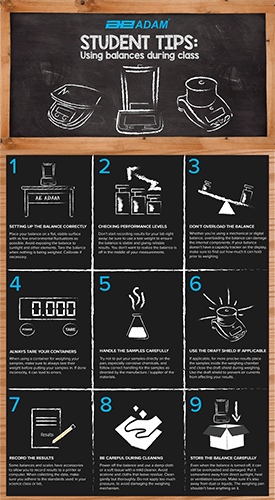
Throughout much of the world, students are preparing to head back to school. Scales and balances are an important part of science curriculums and classrooms, helping students understand the world around them as they learn about important concepts like mass and weight. In this blog, we’ll look at some of the ways weighing devices can be used from primary schools all the way up through universities.
Illustrating Weighing Concepts for Students
When it comes to illustrating basic mass measurement concepts, a triple beam mechanical balance like TBB offers the ideal solution. Notched sliding weights allow students to easily see the weighing process firsthand as the weights are manually shifted by the user to achieve balance between the weights and the object being weighed on the pan.
While digital scales offer finer readabilities, the classroom advantage of a triple beam balance lies in the illustration of the principles of balance, where a digital scale simply displays the weight of an object without the student seeing how it works.
Classroom Weighing
We’ve covered tips for students using balances in class in a previous blog, as well as in this handy, downloadable infographic. These tips apply to classroom weighing regardless of the age of the students and, in fact, equally apply to using a balance in any location. Here’s a quick refresher:
- Ensure that the balance is set up properly, on a flat, stable surface where environmental fluctuations can be minimized.
- Use a test weight to check the balance’s results before recording the results for the class’s experiments.
- Don’t overload the balance! You can damage its internal components, so always be aware of your balance’s maximum capacity.
- If you’re using a container to hold the substance being weighed, make sure to tare the container’s weight. This means that the scale or balance should read zero when the empty container is the only thing on the pan.
- Many highly sensitive balances come with draft shields to minimize disturbances from air currents, whether wind outside or air conditioning inside. If your balance has a draft shield, use it and close its door during weighing.
- When you’re done using the balance, carefully and gently clean it with a damp cloth or a soft tissue with a mild cleaner before storing it.
Which Scales are Best for Each Age Group?
Many scales and balances can be used for students of all ages and abilities, but as they progress in their education, it’s helpful to have access to more advanced equipment with additional functionality and applications to support their lessons.
As younger children first learn to use a scale and learn about weighing concepts in elementary (or primary) school, simpler devices like a triple beam balance or an easy-to-use compact balance like Dune make sense for them. These are often highly affordable and very durable.
Junior high (secondary school) students benefit from balances with more applications that can expand upon the knowledge gleaned from earlier classroom lessons. Compact balances Core, CB and CBX are all well-suited for junior high use and offer the versatility of battery or AC power. CBX’s rechargeable battery can be recharged via USB cable.
At the high school level (particularly in AP classes), precision balances like Luna and Highland offer more advanced applications for curriculum-based experiments. Different science disciplines would have different requirements. For example, chemistry classes need a two- or three-place balance, while physics classes could utilize readabilities of 1g or 0.01g.
College students frequently use balances for advanced science education, chemistry and university science labs. A Luna analytical balance would be ideal for university-level science classes and labs.
Education Resources
Once the scale or balance is in the classroom, now what? Adam Equipment offers free downloadable online resources to assist educators. Our experiments were designed by teachers for teachers and each includes a reproducible student activity sheet, connections to standards, a vocabulary list, possible extensions, and an answer key.

Resources include experiments to learn about density, osmosis, the Law of Conservation of Matter, soil chemistry and thermochemistry.
Are you a teacher with a fun educational experiment you’d like to share with us? Email education@adamequipment.com to pass it along!
Questions about what type of balance may be right for your classroom? Adam Equipment can help. Click here to contact us for assistance.


